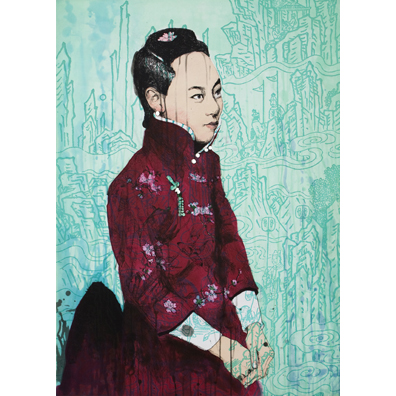Artwork Description
Hung Liu – Shan – Mountain
Dimensions: 47 x 36″ finished size
Year: 2012
Medium: color aquatint etching with gold leaf on paper
Edition: HP1
© Hung Liu Estate, ARS, NY
“The names of the paintings themselves allude to the Chinese name for landscape paintings (shan shui hua, literally “mountain river paintings”) where towering mountains and sweeping rivers dwarf the occupants of the land. Although she imitates the aesthetics of landscape painting, Liu ultimately subverts their focus. Rather than emphasizing nature’s grandeur, she asserts the dignity of these individuals. By blending Western portraiture with Chinese landscape painting, Liu casts her subjects as monumental figures that stand independent of time or place. History may pick and choose who to remember, the paintings seem to say, but the integrity of the human spirit will thrive regardless.”
Hung Liu has been acclaimed as the greatest female Chinese American artist of her time. Dr. Dorothy Moss, who curated Liu’s award-winning career retrospective at the Smithsonian Institution’s National Portrait Gallery, unveiled the deep history and humanism in Liu’s lifetime body of work. Liu was born in 1948 in a part of northern China experiencing famine, and her family was forced to migrate when she was only a baby. Her father, a Nationalist, was captured and sent to a labor camp at that time, and Liu was not reunited with him until fifty years later, shortly before his death.
Liu, herself was sent to the Chinese countryside to labor in the fields for four years, and there she drew strength from the power of art. She secretly painted, drew, and photographed the village workers, seeing in them the human dignity that she wanted to share. Later, she turned her attention to the young girls who were sold into sex work by their impoverished families. These women had been commodified, their names replaced with the names of rare gemstones or beautiful flowers as their services were marketed to wealthy men. Like the countryside villagers she had rendered previously, she created beautiful places for these women to rest in perpetuity, on backgrounds of gold or silver, surrounded by flowers and other offerings.
—Xiaoxiao Meng was the summer 2017 publications and communications/marketing intern at the National Museum of Women in the Arts.

